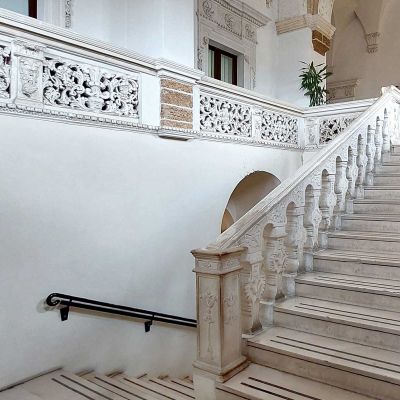Celestine Monastery
The Celestine fathers probably settled in Mesagne around the XIV century. Their monastery, according to the contemporary historian Mannarino, was situated inside the defensive walls next to the church of Saint Bartholomew. The Celestines, thanks to the bequests of various noble Mesagnese families, were able to construct a new monastery beyond the town’s walls near the Porta Piccola (Small Gate) next to the 16th century church of Santa Maria in Betlem (Saint Mary of Bethlehem).
Initially, the Celestines built a monastery of modest dimensions and they restored the attached church. The Mesagnese Celestine abbot, Pietro Paolo Leopardi, was the promoter of the new construction. But the wealth of the Celestines notably increased after 1616, when Pope Paolo V suppressed the congregations of the Celestine order under the title of Saint Angelo, and the assets of the orders of Alessano, and after, those of the S. Arcangelo (Blessed Archangel), and of Saint Peter of Brindisi and Urgento passed to the monastery in Mesagne. In 1634 the monastery in Mesagne became an abbey.
In the following decades the Mesagnese Celestines were in favour with the Cardinal Mario Albricci Farnese, descendent of the feudal lords of Mesagne, and in 1671 they acquired numerous allodial (free from tenurial rights of a feudal overlord) properties, thus expanding their patrimony further, and so, it was in 1660 that they started the construction of the new church attached to the monastery. During the reconstruction great care and attention was taken to recover a miraculous picture of the Vergine Santissima della Sanità (Blessed Virgin of Health). It was believed to be that painting that had saved Mesagne during the plague epidemic of 1528. A portion of the painting is still visible today above the altar of S. Pietro Celestino.
In 1711, they started the expansion of the monastery and the work carried on until 1738. The work was carried out almost certainly, at the beginning, by the Leccese master craftsmen Pasquale and Domenico Antonio de Simone; the latter was also a master architect and it is likely that he furnished the designs for the monastery.
For the expansion of the monastery, the Celestines committed enormous sums of money. In that district there were the workshops of the ceramists, and the monks had to purchase them to obtain the space required to build. In 1797, Ferdinando IV and his entourage were hosted at the monastery and it was on that occasion that the monastery was conferred its royal title.
After the suppression of the Celestine order, the municipality decided to take-on the monastery as a municipal building and decurionale, then as a barracks and a district magistrate’s office.
Later, in 1873, it was permanently acquired by the municipality.
In the previous century the different rooms and spaces were employed for various public uses such as a nursery, elementary school, prison and cinema. Currently it is the headquarters of the local municipality.




